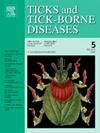中欧国家的蜱虫危害:绘制欧洲主要蜱传疾病媒介在德国的地图
IF 3.4
2区 医学
Q2 INFECTIOUS DISEASES
引用次数: 0
摘要
欧洲最常见的蜱种蓖麻伊蚊是伯氏疏螺旋体和蜱传脑炎病毒以及与欧洲公共卫生相关的其他几种病原体的主要媒介。关于蜱虫丰度和潜在生态驱动因素的综合数据对于制定认识和控制战略以及评估蜱传疾病风险的未来变化至关重要。我们的目标是提供德国范围内蓖麻毒素丰富度的地图,以帮助疾病传播风险评估。在2018 - 2020年期间,在全国83个地点采用拖拽标记法评估了蜱虫密度,共收集到49,344只蓖麻蠓稚虫和成虫。研究了气候、土地覆盖和月探测蓖麻若虫密度之间的关系,并绘制了丰度图。蜱虫危害最高的地区为冬季温和、春季湿润的沿海地区和中高海拔山区,这些地区是旅游胜地。蜱的季节性活动模式以单峰为主。观察到的区域差异与先前基于区域研究组合的估计相矛盾,这一事实说明需要进行广泛和协调的抽样工作,以便在更大的空间尺度上可靠地估计蜱虫丰度。结合蜱传病原体的数据,我们的研究能够估计受感染蜱的密度,从而获得传染性蜱叮咬的风险。此外,观测到的与气候和土地覆盖的关系有助于预测中欧不同气候情景下蜱害的未来发展。本文章由计算机程序翻译,如有差异,请以英文原文为准。

Tick hazard in a Central European country: Mapping Europe’s principal tick-borne disease vector across Germany
The most common European tick species, Ixodes ricinus, is the principal vector of Borrelia and tick-borne encephalitis virus and several other pathogens of public health relevance in Europe. Comprehensive data on tick abundance and the underlying ecological drivers are crucial for developing awareness and control strategies and to assess future changes in tick-borne disease risk. We aimed to provide a Germany-wide map of I. ricinus abundance to aid in disease transmission risk assessment. During 2018−2020, questing tick density was assessed at 83 sites across the whole country by drag flagging, whereby 49,344 I. ricinus nymphs and adults were collected. Relationships between climate, land cover, and monthly questing I. ricinus nymph density were explored and used to draw an abundance map. Highest tick hazard was observed in areas near the coast with mild winters and moist springs, and in mid-elevation mountain ranges, which represent popular tourist destinations. The ticks’ seasonal activity pattern was predominantly unimodal. The fact that the observed regional differences are contradictory to a previous estimation based on a combination of regional studies illustrates the need for an extensive and coordinated sampling effort to reliably estimate tick abundance at larger spatial scales. Combined with data on tick-borne pathogens, our study enables estimating the density of infected ticks and consequently the risk of acquiring an infectious tick bite. Moreover, the observed relationships with climate and land cover can help to predict future developments of tick hazard under different climate scenarios in Central Europe.
求助全文
通过发布文献求助,成功后即可免费获取论文全文。
去求助
来源期刊

Ticks and Tick-borne Diseases
INFECTIOUS DISEASES-MICROBIOLOGY
CiteScore
6.90
自引率
12.50%
发文量
185
审稿时长
6-12 weeks
期刊介绍:
Ticks and Tick-borne Diseases is an international, peer-reviewed scientific journal. It publishes original research papers, short communications, state-of-the-art mini-reviews, letters to the editor, clinical-case studies, announcements of pertinent international meetings, and editorials.
The journal covers a broad spectrum and brings together various disciplines, for example, zoology, microbiology, molecular biology, genetics, mathematical modelling, veterinary and human medicine. Multidisciplinary approaches and the use of conventional and novel methods/methodologies (in the field and in the laboratory) are crucial for deeper understanding of the natural processes and human behaviour/activities that result in human or animal diseases and in economic effects of ticks and tick-borne pathogens. Such understanding is essential for management of tick populations and tick-borne diseases in an effective and environmentally acceptable manner.
 求助内容:
求助内容: 应助结果提醒方式:
应助结果提醒方式:


